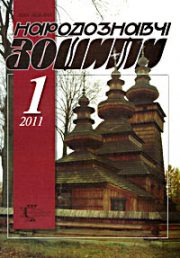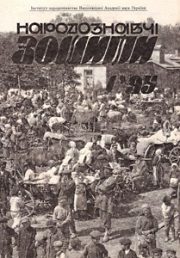The Ethnology Notebooks. 2022. № 2 (164), 304—313
UDK [398.2(=161.2):801.81]:[329.73( 477.8)”194/196″:17.022.1]
DOI https://doi.org/10.15407/nz2022.02.304
KHARCHYSHYN Olga
- ORCID ID: https://orcid.org/0000-0002-9379-8300
- Candidate of Philological Sciences (Ph. D. in Philology),
- Senior Researcher at the Ethnology Institute
- of National Academy of Sciences of Ukraine,
- 15, Svobody Avenue, 79000, Lviv, Ukraine,
- Contacts: е-mail: okharchyshyn@gmail.com
Abstract. The research is based mainly on own records of recent years from the western part of Ukraine. There, during the Second World War and post-war disasters, the Ukrainian Insurgent Army rose to protect the lives and dignity of Ukrainians (UPA, 1943—1956). The UPA fought simultaneously against the Nazi and Moscow-Bolshevik occupiers, and in the postwar years against the establishment of the Moscow-Imperial regime — the so-called Soviet power. Human dignity is a fundamental cultural value that underlies natural law, the need for which is proclaimed in the Declaration of Human Rights (1948). In the narratives studied, the narrators hardly use the word «dignity» but express the essence of this concept through a number of motives («bullying: beatings, torture», «desecration of the bodies of the dead», «deprivation of the right to decent living»), which emphasize the criminal violations of human dignity by the occupiers and the forms of resistance of Ukrainians to these crimes. Appealing to the «human/animal» dichotomy means that the narrator is aware of the violation of the right to human dignity and the condemnation of violators of this right, mainly German and Russian conquerors. At the same time, this dichotomy primarily appears as opposition to «man is not an animal», claiming that man has dignity. Such coverage of the concept of «human dignity» in the historical narratives of Ukrainians has become necessary in the system of values established in Ukraine after the Revolution of Dignity (2013—2014).
The topic’s urgency is due to the importance of understanding the main value priorities in the process of Ukrainian nation-building and integration in the European space. The object of the research is memoirs and legends about the national liberation struggle of Ukrainians in the 1940s and 1960s, recorded from participants or eyewitnesses of this struggle, as well as from their descendants. The subject of the research is the motto «man is not an animal» as a folklore manifestation of the concept of «human dignity» in the context of the events of the mid-twentieth century in Ukraine.
Keywords: human dignity, concept, motif, narrative, man, animal, value, Ukrainians, occupiers.
Received 10.05.2022
REFERENCES
- Golovaty, S. (2016). On human rights. Lectures. Kyiv [in Ukrainian].
- (1948). Universal Declaration of Human Rights. Adopted and promulgated by UN General Assembly Resolution 217 A (III) of December 10, 1948. Retrieved from: https://zakon.rada.gov.ua/laws/show/995_015?find=1&text=%D0%B3%D1%96%D0%B4%D0%BD%D0%BE%D1%81 (Last accessed: 28.04.2022) [in Ukrainian].
- The Constitution of Ukraine. Retrieved from: https://zakon.rada.gov.ua/laws/show/254%D0%BA/96-%D0%B2%D1%80#Text (Last accessed: 28.04.2022) [in Ukrainian].
- Manifesto of the Organization of Ukrainian Nationalists. Retrieved from: https://avr.org.ua/viewDoc/1377/ (Last accessed: 30.04.2022) [in Ukrainian].
- Kis, O. (2017). Ukrainka in the Gulag: to survive means to win. Lviv: Institute of Ethnology of the National Academy of Sciences of Ukraine [in Ukrainian].
- Lunyo, E.(Ed.). (2017). Yavoriv region in the insurgent struggle. Stories of participants and eyewitnesses (Vol. 1: Nakonechne the First. Nakonechne the Second). Lviv [in Ukrainian].
- Lunyo, E.(Ed.). (2015). Yavoriv region in the insurgent struggle. Stories of participants and eyewitnesses (Vol. 2: Yavoriv). Lviv [in Ukrainian].
- Lunyo, E., Lunyo, P., & Duda, L. (Eds.) (2021). Insurgent struggle in the stories of participants and eyewitnesses (Vol. 3: Buniv, Ivanyky, Kalynivka, Porudenko, Nakonechne Pershe, Nakonechne Druhe). Lviv; Drohobych [in Ukrainian].
- Kuzmenko, O. (2018). Dramatic Human Existence in Ukrainian Folklore: Conceptual Forms of Expression. Lviv [in Ukrainian].
- Lunyo, E. (2011). Chief Commander of the Ukrainian Insurgent Army Roman Shukhevych in the folklore prose of Yavoriv region. Ethnographic notebooks, 1, 43—65 [in Ukrainian].
- Lunyo, E. (2015). The figure of Metropolitan Joseph the Blind in the story of a cellmate from Yavoriv region. Ethnographic notebooks, 5, 1005—1016 [in Ukrainian].
- Gavrishko, M., & Kis, O. (Ed.). (2017). Women in the national underground: contributions and losses. Ukrainian women in the crucible of modernization (Pp. 204—232). Kharkiv [in Ukrainian].
- Ostroverkh, M. (2011). Man as a «political animal» in the philosophical concept of Aristotle. Bulletin of Kharkiv National University V.N. Karazin (Issue 958-1). Series: theory of culture and philosophy of science (Issue 44). Kharkiv. Retrieved from: https://periodicals.karazin.ua/thcphs/issue/view/205 (Last accessed: 28.04.2022) [in Ukrainian].
- Le Bra-Chopar, A., & Shevchenko, V. (2009). Philosophical Zoo: from boiling to removal from humanity. Kyiv [in Ukrainian].
- Zhulinsky, M. (2017). My Second World. Chronicle novel in voices. Kyiv [in Ukrainian].
- Sishchuk, M. (2014). Like an Easter egg, the village of Zelena. Drohobych [in Ukrainian].
- Kuzmenko, O. (Ed.). (2005). Ukrainian Sich Riflemen’s songs. Lviv [in Ukrainian].
- Chebanyuk, O., & Kovaleva, O. (Eds.). (2019). Maidan. Direct speech (Book 1). Kyiv (Oral history of the Maidan) [in Ukrainian].
- Chebanyuk, O., & Kovaleva, O. (Eds.). (2019). Maidan. Direct speech (Book 2). Kyiv (Oral history of the Maidan) [in Ukrainian].





